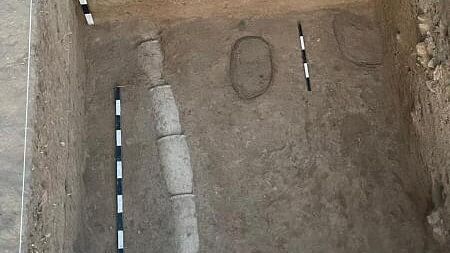
Terracotta pipeline dating back to 6th century BCE unearthed in Tamil Nadu's Keeladi.
Credit: DH Photo
Chennai: Archaeologists have unearthed a terracotta pipeline in the 10th phase of the excavation in Keeladi, a Sangam Era site, in yet another evidence of the effective water management practices followed by those who inhabited the settlement at least 2,600 years ago.
The discovery comes weeks after archaeologists in the same site found a potsherd with Tamil letter ‘Tha’ inscribed on it, two potsherds adorned with fish motifs, broken copper objects, beads, spindle whorls, hopscotch, and heaps of potsherds.
Keeladi, which was first discovered in 2014 by K Amarnath Ramakrishna of the Archaeological Survey of India (ASI), is located 12 km southeast of Madurai and has now emerged as one of the top tourist spots in the ancient city, once ruled by the Pandya Kingdom. Over 20,000 artefacts and antiquities have been recovered in the past nine years from Keeladi.
A pipeline in a cylindrical shape in an aligned manner was found penetrating from one trench to another trench.
“This earthen drain consists of six casings that are neatly fitted together. The length and breadth of a flint casing are 36 cm and 18 cm respectively. The currently exposed drain has a length of about 174 cm. A continuation of the pipeline extends into the next trench,” an archaeological officer (AO) told DH. The AO added that the pipeline could have been used for carrying protected water.
“This shows that the inhabitants of Keeladi practised effective water management skills. We will know more about their practices once we get to know what is there in the other trench,” the AO added.
The Tamil Nadu State Department of Archaeology (TNSDA) has established that the Tamil society was literate as early as the 6th Century through carbon-dating analysis of artefacts found in the Sangam-era site.
“Archaeologists have established that an urban civilization existed on the banks of River Vaigai through shreds of evidence of habitat, coexistence of different populations, literacy, brickmaking, various industries like beads, and terracotta, and efficient water management,” another official said.
The excavations come at a time when the exercise has created a buzz in the past few years after they threw up surprises. Artefacts unearthed in Keeladi pushed the Sangam Era to 600 BCE from 300 BCE, rice husks found in a burial urn in Sivakalai were found to be 3,200 years old, and Tamils were aware of iron technology in 2172 BCE, 4,200 years ago.
The carbon dating pushed the Sangam Era by three hundred years that it was thought to be. The Archeological Survey of India, which conducted the first two phases of excavation, also derived the period of the Sangam-era archaeological site to be between the 8th century BCE to the 3rd century CE.
These findings come amidst repeated assertions by Chief Minister M K Stalin that his government will take every step to scientifically prove that India’s history will have to be rewritten from the Tamil landscape, in the light of findings in Keeladi and Sivakalai.